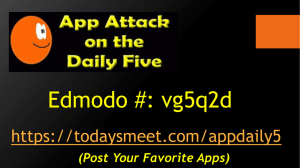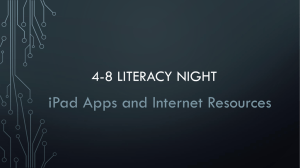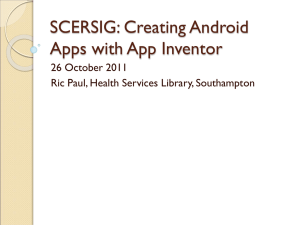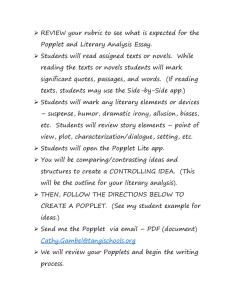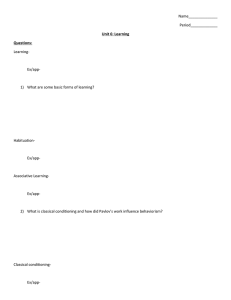Campbell-IPAD-Pilot-Update-for-PTA
advertisement
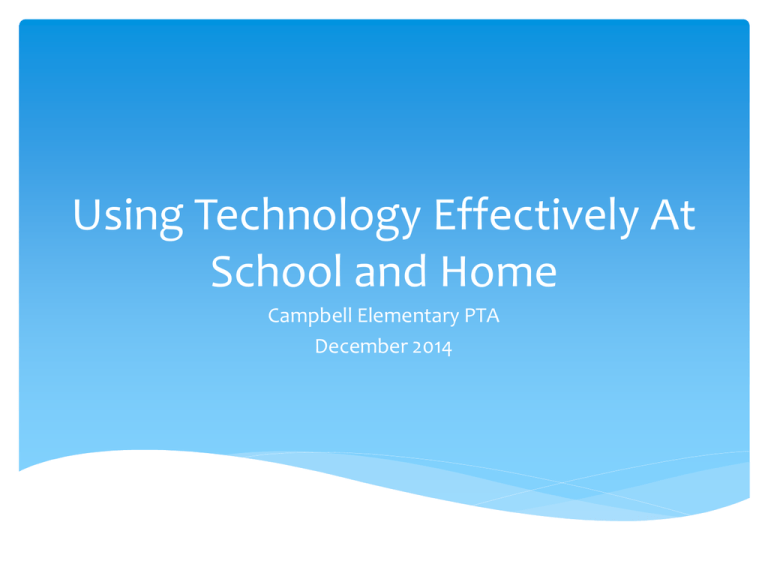
Using Technology Effectively At School and Home Campbell Elementary PTA December 2014 “Google CEO Eric Schmidt [was asked] what he thought education should look like going forward. Schmidt answered succinctly, ‘Teaching will be learning how to ask the right questions. I was taught to memorize. Why remember it? Now you just need to learn how to search for it. Instantaneous access really changes your life. What never changes is the need for curiosity. What you need to do is teach people to be curious.’” -Connecting Comprehension and Technology (Harvey & Goudvis, 2013). Why Technology is Important and Can Be Beneficial If Used Properly Technology has changed and continues to shape education and our world society forever. 88% of young adults (18-29) own a smartphone, according to a Dec 2013 Gallup poll (Rates may have increased in a year). The job market and society of tomorrow is not the same as yesterday’s or even today’s. Why Technology is Important and Can Be Beneficial If Used Properly Think about: Encyclopedias vs. Google; Youtube videos to learn how to build something; TedTalks or Khan Academy Are we adequately preparing students for the future if we ignore technology? Negative consequences of widespread technology, such as cyberbullying, are a reality. They will not be solved by removing technology from schools and hoping children will never use it. We must instead address and teach children digital citizenship. Why Technology is Important and Can Be Beneficial If Used Properly We need to equip our children with skills to improve collaboration, understanding and safe use of technology, and digital citizenship to create citizens of a world where technology is used for good. Find technology that does things better than other physical tools (or otherwise wouldn’t be possible). Example: Googledocs allows students to collaborate on the same document at once, which requires more challenging collaboration skills and often higher-level thinking. SAMR Model Instruction that Integrates Technology At School Educreations (or other screencasting apps like Doceri, ShowMe, Teach by Knowmia, Screenchomp) Lino (or other sticky note apps like iBrainstorm) Popplet Lite Raz Kids AirSketch Free Googledrive Splashmath Brytewave K12 Overdrive News-o-matic LetterSchool Example 1: Confer Even teachers without the ipad initiative have begun using this app with their new teacher ipad. It is a conferencing tool to use in a Reader’s Workshop, Writer’s Workshop (or Math Workshop!) It easily organizes and sorts student data such as teaching points, strengths, and goals, so that teachers can more effectively and efficiently differentiate! Example 2: Popplet Lite Graphic organizer app allows for many instructional purposes, such as in Ms. McAleer’s class 3. Educreations or other screencasting apps These apps allow for students to express their thinking and allow for me to later assess all children’s understandings of concepts in a more time efficient manner. We will see an example at the end! 4. Lino This collaborative sticky note app allows all students to participate in an interactive read aloud and gives teacher instant assessment of student thinking, such as in Mr. Schoenherr’s class. 5. GoogleDrive 6. Letter School Ms. Sutherland and other Pre-K teachers use this app to practice fine motor skills, letter formation, and letter recognition! Recommended Uses of Technology At Home Many school apps are collaborative Home apps are best for independent work For example: www.Graphite.org Searchable web site for apps To find targeted skill practice Example: finding an app for multiplication if your child struggles in multiplication Follow them on Twitter for short lists of recommended apps Setting Up Structures Digital Citizenship At Home: Talk to your child Set clear guidelines Possibly set up time limits, security settings, and rules for using technology in your house. Ask your child to share the apps they are using. 1. Raz Kids (free) RAZ KIDS- free to download or go to www.razkids.com for free Enter your class username Choose your child’s name from the list The Raz kids designers create about 11 new books every month, and they are increasing in quality and topic! 2 & 3. BryteWave and Overdrive (free) Brytewave K-12 app or www.wbb37464.follettshelf.com Free digital books managed by the Campbell Librarian, Mrs. Decker! Your username is your child’s student ID number, and the password is your child’s school Google Drive password. If on the app, you also need to enter the web site address above. Overdrive app or www.library.arlingtonva.us/ebooks - Free digital books via the public library. You will need to enter your child’s library card number and change the settings to ensure that kid- friendly books are available. 4. Popplet Lite (free) Popplet Lite app- This free app allows students to plan, organize, and create graphic organizers about any project or book. 5. Little Story Creator (free) Little Story Creator app- This free app allows kids to create digital books of their own! 6 & 7. Booksy & Newsomatic (free apps but you can purchase more in app) Booksy app- A few free books are included in this free app. These are very high quality digital texts for all levels! News-o-matic app- 10 free issues with 5 articles in each, then you have to pay after that. This is a fantastic app which allows kids to interact with kidappropriate but important global current events with engaging texts. 8, 9, & 10. Paid apps (but 2 have free web sites) Word Wizard app- This $3 app allows for practice with letter sounds, sounding out words, and spelling (all levels of word study). Learner’s Dictionary or www.learnersdictionary.com - $5 for app, free web site: Allows students to look up vocabulary in kid-friendly, easy-to-understand definitions. Starfall app $3 or www.starfall.com for free- Learn letter sounds and read books that focus on one sound or word study level at a time. THANK YOU! Thank you so much for listening! I hope we all will take steps now to help kids effectively use technology as digital citizens of the modern world!

